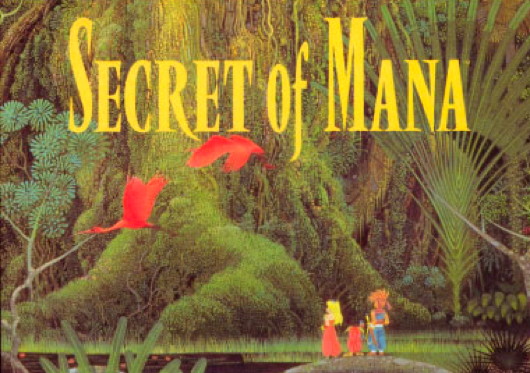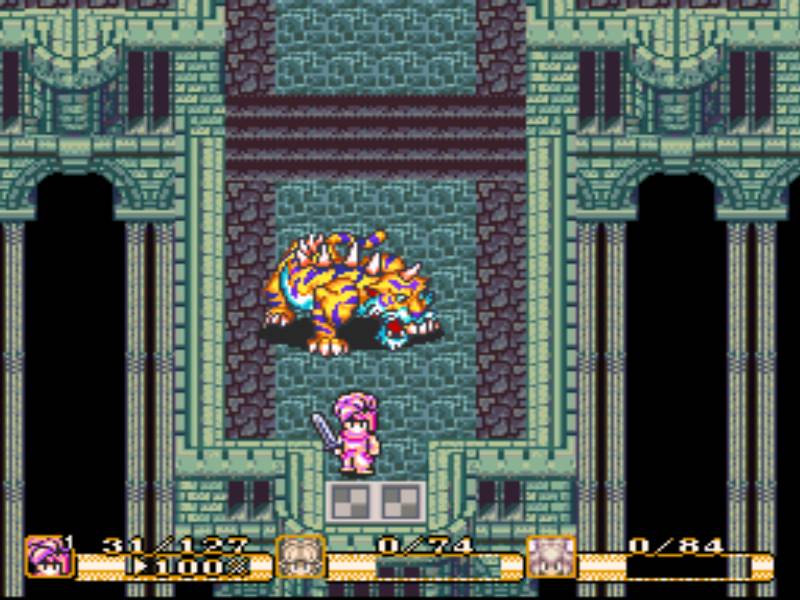Last updated on October 29, 2013
Apparently, Mana has become relevant again in the mainstream press, but I already had the ideas written down, so here they are! You can call it “Fall of Seiken Densetsu Part 4 and 5 if you’d like (and you should read those too, if you haven’t). Surprise, surprise! Bet you didn’t expect this one at all. Heck, if I didn’t get to talk about Secret of Mana for entirely too long an article, I’d probably explode.
It is here that we finally arrive at Seiken Densetsu II, or Secret of Mana for you Western audiences. This was the game that started it all (Apart from the first game, of course) in really defining a specific game style, and it’s such a fantastic game for reasons that aren’t even related to mechanics, storyline, aesthetics, or anything related to the common “video games” review process, though those certainly help! Rather, for me, those things are ancillary to what Secret of Mana did well, and still does well, relative to it sequels and cooperative counterparts. In fact, it did these things so well that the series eventually fell into disrepair and never recovered; it is my desire to convey the elements that Koichi Ishii was missing when he continued to drive the series forward, and why they contribute to Mana’s success even now. These are the reasons why the fans of Seiken Densetsu cling to the series – for those rare exceptions, I salute and pity your dedication at the same time, while questioning your sanity.
Talking about Secret of Mana in any objective way, for me, is far from objective. It was the first video game I played with any semblance of skill or desire to suceed. Sure, I’d played Super Mario Bros., Zelda, all the good games of the NES and the SNES era up to that point, but there weren’t many experiences at the time that were epic. Full of things to do. Long, with some kind of story – to a six year old, it was pretty amazing, anyway. FFIV was fun and fantastic, but I’ll admit I didn’t really love it until I got older. For me, Secret of Mana marks my first foray into a video game to the point of obsession. I received it as a group gift over a Christmas vacation, and my father and brother proceeded to play through the game with me for days and days on end. Hey, a formative experience can involve a video game, can’t it?
My brother had to be the Hero, the most powerful melee attacker in the game – perhaps not by choice, as he soon discovered that I had actually played the coolest character. I picked the Sprite because, hey, casting magic is cool and that’s what I wanted to do. My father, being the selfless one, ended up as the Girl, if only because there weren’t many options to be had. There’s not much choice, in that sense, between characters and styles, but the ones that are there complement each other well. The Hero is pure physical attack power; the Sprite, for all intents and purpose, finds little use outside magic; and the Girl strikes a balance between the two, and usually becomes the resident healer of the group. As far as a single player game goes, this would be pretty standard RPG fare in 1993 with an entirely balanced party foisted upon the player (see: FFIV).
A few elements make the combat more entertaining that it should be – otherwise, it’d just be Zelda with prettier graphics, right? The charge attack system, though somewhat buggy and unreliable, forces you to make a choice: do you wait to charge for a more powerful attack, or simply attack normally? Each weapon can gain a charge up to 8 levels, and each one makes the characters perform a unique, expressive, and extremely damaging, finishing move. Of course, there’s a twist in that getting hit loses your charge. It’s essential to use this at the right time, or suffer damage and a lost charge – that’s lots of wasted time, and that’s what you don’t need in a hectic boss battle. Furthermore, magic is performed, and items are used, by pausing the action. This might not seem to be an important element, but it allows you to take a breather, think it over, and strategize if you get stuck. In most games of this ilk, magic usually becomes just another melee attack, but this (and the targeting system, where you choose which one – it’s pretty simple) makes it unique. If I’m not mistaken, most magical attacks can miss entirely, and finding out boss weaknesses is a magical experience in itself (or hilariously frustrating, give or take a good educated guess).
Back in 1993, we’d call these “innovations”, I suppose. Still, they’re just pieces of the experience, rather than the whole; if that was all that attracted you to SoM, I can’t imagine why you’re playing the game at all unless you like a derivative action RPG every once and a while. However, the game comes into its own simply because it is both 1. multiplayer and 2. real-time (except for spell-casting). Multiplayer doesn’t feel like the right word here – cooperative play, rather. These two aspects give it an entirely different feel that most games, forcing a heavy bout of cooperation and coordination to succeed in most instances.
Take, for example, the Spiky Tiger fight:
Ignoring the reason why one of the characters has turned pink (part of the charging animation, bizarrely enough), this is a common sight. The Spiky Tiger totally destroys your party like an uncontrollable hurricane of rage, and you’re left with only the sturdiest party member, soon to meet his own demise. For whatever reason, whether it’s because of the limitations of the party’s abilities at this point or a lack of experience playing the game, Spiky Tiger remains one of the hardest encounters you’ll face in the world of Mana, almost a gear and coordination check for the rest. His attack pattern, though rather simple, is highly unpredictable at times. Even with omniscient powers of prediction, avoiding his attacks can be a hassle, especially as they’ll take out at least a quarter of your life, if not more. Some are completely unavoidable, turning it into a bout of resource management at times. The path to the boss, in itself, is a trial, and you may be low or supplies (unlike in, say, Seiken Densetsu 3). Whatever the case, the boss fight requires intense concentration, tactics, reflexes, an acuity for detecting patterns, and, most of all, teamwork. You simply cannot survive unless you optimally use all of your abilities.
My usual strategy goes as follows: Hero uses the Sword (duh), charging attacks until an opportunity presents itself; the Girl attacks unless needed to use Cure Water, one of the most useful spells in the whole game. The Sprite, on this fight, tends to be left in the dust in terms of usefulness regarding magic, so the Bow remains the only viable option (the boss isn’t very vulnerable to spells, anyway, so there’s no point wasting precious MP). Even if you’re the appropriate level (around 9-10, by my reckoning), it’s by no means an easy battle, and you will get rocked until you understand what you’re supposed to be doing. Discovery, unlike in many modern games, is part of the fun here, whether in exploring the world or seeking the proper tactics to defeat a foe.
In single player, I imagine it’s fun to figure out what you’re supposed to do, but the AI in this game, unsurprisingly, seems a total afterthought. When fighting Spiky Tiger, the last thing you need is an AI companion trying to kill himself because he doesn’t seem to understand the basic concepts of video games beside “attack”. They will make you tear your hair out because they are stupid. No, the real, and obviously designed, experience lies in co-op play. Spiky Tiger isn’t a pushover with competent allies, but he will challenge your coordination and ability to develop a proper strategy that takes into account all the items you have, how many levels your weapons/magic has, and whether or not the fight’s even possible at your current level. This is what makes Secret of Mana so engaging: other people. It’s the interaction with your video game companions in real life, rather than the game, that pushes it into the upper echelons. Otherwise, it’s a bog standard RPG from the early 1990s, which looks attractive but retains little else of appeal or note. I’m trying to figure out why you would play the game without two friends to cover your back; it’s for the masochists of the world, or those who just really like the setting. I can applaud your dedication, but I can say on pretty good authority, namely myself, that you are playing the game wrong.
Let’s get this “play your own way” issue out of the way. Developers make a game and give you tools. Whatever the case, the director of a game, if he or she understands the job, has a particular goal and experience to give to the players. You can play the game the “wrong” way, so to speak, and miss out on the experience they are trying to provide, or you can enjoy the game infinitely more by understanding its mechanics. I suppose this isn’t that apparent from first glance with Secret of Mana, but many game nowadays have NOT done a great job of making this element straightforward and obvious by limiting the player’s options. My recent playthrough of Arkham Asylum made that obvious enough – the more things they give you to do, the more you wonder why you can’t use ability X, or move in ability Y. It’s a constant battle for the player’s suspension of disbelief, and if he’s discovering what he/she cannot do, the illusion evaporates. The handholding of the modern game acts as a straight-jacket. I wouldn’t have had half as much fun in Vanquish, for example, if I was trying to play it like Gears of War as many did; it’s meant to be played fast, like an arcade game or time attack racing game mode, and if you don’t play that way, you won’t get why it’s good.
Mana doesn’t have this problem; the prospect of three players was exposed from the outset, and it was packed with the multi-tap in many areas of the world (not the U.S., unfortunately; that honor went to Super Bomberman, and the multi-tap had the little Hudson bee on it too). Anyone buying it clearly had an inkling from Nintendo Power that three players was the de facto standard; that’s what I remember so many years ago. Secret of Mana is a cooperative game, through and through, and it has as much to do with your real life companions as the game itself. I imagine this works for every multiplayer game ever made, but it’s particularly effective here.
There’s a few specific reasons for this…
Continued in Part 2.


